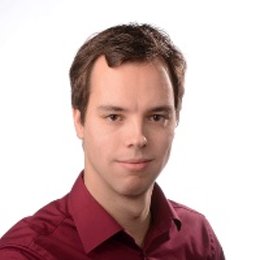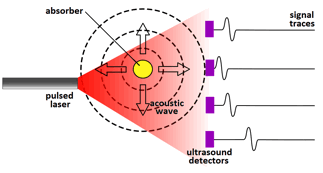Developing Reconstruction Techniques for Photoacoustic Tomography using Image Analysis for the Detection of Breast Cancer
Organization:
Funded by: | UT |
PhD: | Yoeri Boink |
Supervisors: | chair AA: Chair BMPI: |
Collaboration: | Biomedical Photonic Imaging group (UTwente) |
Description:
Photoacoustic Tomography (PAT) is an emerging biomedical imaging technique in which tissue is illuminated by a laser pulse with a specific wavelength. The emitted photons are scattered and absorbed by the tissue. The absorbed photons are converted to heat energy, which causes a local pressure increase in the tissue. Consequently, a pressure wave travels through the tissue, after which it is detected by ultrasonic transducers in a specific measurement geometry. Because of different concentrations of absorbsing molecules, different kinds of tissue can be identified.
Within the BMPI group a second generation Photoacoustic Mammoscope is being developed, which is used to image breast tissue for the detection of breast cancer. A software program based on a basic imaging algorithm is available, for reconstructing phantom and in vivo data. However, there is a requirement for more advanced algorithms, which will correct for non-ideal nature of the imaging system such as limited detection bandwidth, and presence of noise, to provide improved images. Further, there is also a requirement to make use of a priori known spatial and spectral information regarding the clinically relevant targets to not only improve the images, but also provide extraction of features relevant for diagnosis in the future.
Various ideas in the field of inverse problems will be devoloped for the reconstruction problem, such as the use of iterative methods and regularisation approaches. More specifically, total variation and anisotropy will be incorporated in the regularisers. Furthermore, compressed sensing techniques will be studied to deal with subsampling of the data which is the result of the limited amount of measurement transducers or the wish to make a faster acquisition of data. In Quantitative PAT, one obtains the absolute concentrations of absorbing molecules (chromophores) by using laser pulses of multiple wavelenghts. Techniques to solve the ill-posed and non-linear QPAT inverse problem will be developed. Specific 2D and 3D-measurement setups will be considered for this project. The algorithms will be tested on numerical phantoms, and on experimental data from physical phantoms and in vivo measurements. The research will be performed in the groups Applied Analysis (AA) and Biomedical Photonic Imaging (BMPI). Experimental data will be provided by BMPI and the UT startup PA Imaging BV.
Output:
Pictures:
| |
| |







